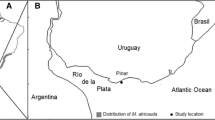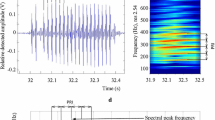Abstract
The whitemouth croaker produces two different sounds using extrinsic sonic muscles: (1) male advertisement calls during the spawning season and (2) disturbance calls, produced by both sexes. The advertisement call, related to courtship, was recorded in the field and from two marked spawning males of 28 and 30.5 cm LT in the laboratory. It consists of individual pulses with average durations of 19.7 ms and 17.8 ms for the two males respectively, interpulse intervals of 496 ms and 718 ms, and dominant frequencies of 280 Hz and 316 Hz. Pulses are emitted in bouts of one to three min duration. Disturbance calls consist of a burst of pulses produced at short intervals, and the pulse duration, interpulse interval and dominant frequency of the pulses average 19.8 ms, 17.1 ms, and 363 Hz, respectively. Dominant frequency and interpulse interval decrease and pulse duration increases with fish size. Sound characteristics change markedly in young of the year individuals (lower than 25 cm LT) after which they appear to stabilize. Higher dominant frequency in the advertisement than in the disturbance call and the relationship of dominant frequency to pulse duration suggest that dominant frequency is determined as a forced response to muscle contraction parameters rather than by the natural frequency of the swimbladder.





Similar content being viewed by others
References
Acha EM, Mianzán H, Lasta CA, Guerrero R (1999) Estuarine spawning of the whitemouth croaker Micropogonia furnieri (Pises: Scianidae), in the Río de la Plata, Argentina. Mar Freshw Res 50:57–65
Amorim MCP (2008) Species differences in courtship acoustic signals among five Lake Malawi cichlid species (Pseudotropheus spp.). J Fish Biol 72:1355–1368
Anderson KA, Rountree RA, Juanes F (2008) Soniferous fishes in the Hudson River. Trans Am Fish Soc 137:616–626. doi:10.1577/T05-220.1
Connaughton MA, Taylor MH (1994) Seasonal cycles in the sonic muscles of the weakfish, Cynoscion regalis. Fish Bull 92:697–703
Connaughton MA, Taylor MH (1995) Seasonal and daily cycles in sound production associated with spawning in weakfish, Cynoscion regalis. Environ Biol Fish 42:233–240
Connaughton MA, Taylor MH (1996) Drumming, courtship and spawning behavior in captive weakfish, Cynoscion regalis. Copeia 1996:195–199
Connaughton MA, Fine ML, Taylor MH (1997) The effects of seasonal hypertrophy and atrophy on fiber morphology, metabolic substrate concentration and sound characteristics of the weakfish sonic muscle. J Exp Biol 200:2449–2457
Connaughton MA, Taylor MH, Fine ML (2000) Effects of fish size and temperature on weakfish disturbance calls: implications for the mechanism of sound generation. J Exp Biol 203:1503–1512
Connaughton MA, Fine ML, Taylor MH (2002) Use of sound for localisation of spawning weakfish in Delawary Bay (USA) and effects of fish size, temperature and season on sound parameters. Bioacoustics 12:294–296
Connaughton MA, Lunn ML, Fine ML, Taylor MH (2003) Characterization of sounds and their use in two sciaenid species: weakfish and Atlantic croaker. In: Rountree RA, Goudey C, Hawkins T (eds) Listening to fish: Proceedings of the International Workshop on the Applications of Passive Acoustics to Fisheries, April 8–10, 2002. MIT Sea Grant Technical Report, Dedham, MA, pp 1–4
Fine ML, Winn HE, Olla B (1977) Communication in fishes. In: Sebeok T (ed) How animals communicate. Indiana University Press, Bloomington, pp 472–518
Fine ML, Malloy KL, King CB, Mitchell SL, Cameron TM (2001) Movement and sound generation by the toadfish swimbladder. J Comp Physiol A 187:371–379
Fine ML, Schrinel J, Cameron TM (2004) The effect of loading on disturbance sounds of the Atlantic croaker Micropogonius undulatus: air versus water. J Acoust Soc Am 116:1271–1275
Fish JF, Cummings WC (1972) A 50-Db increase in sustained ambient noise from fish (Cynoscion xanthulus). J Acoust Soc Am 52:1266–1270
Fish MP, Mowbray WH (1970) Sound of the Western North Atlantic fishes. Johns Hopkins Press, Baltimore
Gannon DP (2007) Acoustic behavior of Atlantic croaker, Micropogonius undulatus (Sciaenidae). Copeia 1:193–204. doi:10.1643/0045-8511(2007)7[193:ABOACM]2.0.CO;2
Hammer Ǿ, Harper DAT, Ryan PD (2001) PAST: paleontological statistic software package for education and data analysis. Palaeontol Electronica 4(1):1–9
Hill AV (1950) The dimensions of animals and their muscular dynamics. Sci Prog 38:209–230
Hill GL, Fine ML, Musick JA (1987) Ontogeny of the sexually dimorphic sonic muscle in three sciaenid species. Copeia 1987:708–713
Holt SA (2002) Intra- and inter-day variability in sound production by red drum (Sciaenidae) at a spawning site. Bioacoustics 12:227–229
Isaac VJ (1988) Synopsis of biological data on the whitemouth croaker Micropogonias furnieri (Desmarest, 1823). FAO: Fisheries Synopsis No 150, 35 pp
Ladich F, Fine ML (2006) Sound-generating mechanisms in fishes: a unique diversity in vertebrates. In: Ladich F et al (eds) Communication in fishes. Science, Enfield, pp 3–43
Ladich F, Collin SP, Moller P, Kapoor BG (eds) (2006) Communication in fishes. Science, Enfield
Lagardère JP, Mariani A (2006) Spawning sounds in meagre Argyrosomus regius in the Gironde estuary, France. J Fish Biol 69:1697–1708. doi:10.1111/j.1095-8649.2006.01237.x
Lin YC, Mok HK, Huang BQ (2007) Sound characteristics of big-snout croaker, Johnius macrorhynus (Sciaenidae). J Acoust Soc Am 121:586–593
Lobel PS (2001) Fish bioacoustic and behaviour: pasive acoustic detection and the application of a closed-circuit rebreather for field study. Mar Technol Soc J 35:19–28
Lobel PS (2002) Diversity of fish spawning sounds and the application of passive acoustic monitoring. Bioacoustics 12:286–289
Lobel PS, Mann DA (1995) Spawning sounds of the damselfish, Dascyllus albisella (Pomacentridae), and relationship to male size. Bioacoustics 6:187–198
Locascio JV, Mann DA (2008) Diel periodicity of fish sound production in Charlotte Harbor, Florida. Trans Am Fish Soc 137:606–615. doi:10.1577/T06-069.1
Luczkovich JJ, Sprague MW, Johnson SE, Paullinger RC (1999) Delimiting spawning areas of weakfish, Cynoscion regalis (Family Sciaenidae) in Pamlico Sound, North Carolina using passive hydroacoustic surveys. Bioacoustics 10:143–160
Luczkovich JJ, Mann DA, Rountree RA (2008) Passive acoustics as a tool in fisheries science. Trans Am Fish Soc 137:533–541. doi:10.1577/T06-258.1
Macchi GJ, Acha EM, Militelli MI (2003) Seasonal egg production of whitemouth croaker (Micropogonias furnieri) in the Río de la Plata estuary Argentina-Uruguay. Fish Bull 10:332–342
Malavasi S, Collatuzzo S, Torricelli P (2008) Interspecific variation of acoustic signals in Mediterranean gobies (Perciformes, Gobiidae) comparative analysis and evolutionary outlook. Biol J Linn Soc 93:763–778
Mok HK, Gilmore RG (1983) Analysis of sound production in estuarine aggregations of Pogonias cromis, Bairdiella chrysoura, and Cynoscion nebulosus (Sciaenidae). Bull Inst Zool Acad Sin 22:157–186
Myrberg AA (1981) Sound communication and interception in fishes. In: Tavolga WN, Popper AN, Fay RR (eds) Hearing and sound communiction in fishes. Springer-Verlag, New York, pp 395–428
Neter J, Wasserman W, Kutner MH (1990) Applied linear statistical models, 3rd edn. Irwin, Homewood
Norbis W (1995) Influence of wind, behaviour and characteristics of the croaker (Micropogonias furnieri) artisanal fishery in the Río de la Plata (Uruguay). Fish Res 22:43–58
Norbis W, Verocai J (2005) Presence of two whitemouth croaker (Micropogonias furnieri, Pisces: Sciaenidae) groups in the Rìo de la Plata spawning coastal area as consequence of reproductive migration. Fish Res 74:134–141
Ono RD, Poss SG (1981) Structure and innervation of the swim bladder musculature in the weakfish, Cynoscion regalis (Teleostei: Sciaenidae). Can J Zool 60:1955–1967
Oosterbaan RJ (1994) Frequency and regression analysis of hydrologic data, part II: regression analysis, chapter 6. In: Ritzema HP (ed) Drainage principles and applications, ILRI Publication 16, second revised edition, Wageningen, The Netherlands
Oosterbaan RJ, Sharma DP, Singh KN, Rao KV (1990) Crop production and soil salinity: evaluation of field data from india by segmebted linear regression with breakpoint. Proceedings of the symposium on land drainage for salinity control in arid and semi-arid regions, February 25th to March 2nd, 1990, Cairo, Egypt, vol. 3 session V, pp 373–383
Parmentier E, Lecchini D, Frédérich B, Brie C, Mann D (2009) Sound production in four damselfisy (Dascyllus) species: phyletic relationships. Biol J Linn Soc 97:928–940
Phillips CT, Johnston CE (2009) Evolution of acoustic signals in Cyprinella: degree of similarity in sister species. J Fish Biol 74:120–132
Puig P, Mesones C (2005) Determinación y caracterización de áreas de desove de corvina. Fren Mar 20:35–40
Ramcharitar J, Gannon DP, Popper AN (2006) Bioacoustics of the family Sciaenidae (croakers and drumfishes). Trans Am Fish Soc 135:1409–1431
Saucier MH, Baltz DM (1993) Spawning site selection by spotted seatrout, Cynoscion nebulosus, and black drum, Pogonias cromis, in Luisiana. Environ Biol Fish 36:257–272
Schneider VR, Hasler AD (1960) Laute und Lauterzeugung bein Suesswassertrommler Aplodinotus grunniens Rafinesque (Sciaenidae, Pisces). Z. vergl. Physiol 43:499–517
Sokal RR, Rohlf FJ (1995) Biometry: the principles and practice of statistics in biological research. W.H. Freeman and Company, New York, 850 p
Sprague MW, Luczkovich JJ (2001) Do striped cusk-eels, Ophidium marginatum produce the ‘chatter’ sound attributed to weakfish, Cynoscion regalis (Sciaenidae)? Copeia 2001:854–859
Tavolga WN (1964) Sonic characteristics and mechanisms in marine fishes. In: Tavolga WN (ed) Marine bio-acoustics, vol 1. Pergamon, New York, pp 195–211
Tavolga WN (1980) Hearing and sound communication in fishes in relation to fisheries management. In: Bardach JE, Magnuson J, May RC, Reinhart JM (eds) Fish behavior and its use in the capture and culture of fishes (ICLARM Conference Proceedings 5, Manilla), pp 102–123
Verocai J (2004) Determinación de edad y crecimiento en la corvina blanca, Micropogonias furnieri (Desmarest, 1823) mediante el análisis del otolito sagitta Unpubl. Master, diss., Universidad de la Republica, Montevideo, Uruguay
Vizziano D (2002) Reproductive cycle of the white croaker, Micropogonias furnieri in the frontal zone of the Rio de la Plata. In: Vizziano D, Puig P, Mesones C, Nagy G (eds) The Río de la Plata. Research to manage the environment, fish resources and the fishery in the saline front (ECOPLATA-UNESCO: Montevideo, Uruguay), pp 103–111
Wainwright PC, Barton RC (1995) Scaling in the feeding mechanism of the largemouth bass (Micropterus salmoides): motor pattern. J Expl Biol 198:1161–1171
Winn HE (ed) (1964) The biological significance of fish sounds. Marine Bio-acoustics. Pergamon, New York
Acknowledgements
We thank Diego Bouvier for his help in the construction of the hydrophone, D. Montiel (Director DINARA) for allowing us to use the research vessel R/V Aldebaran, Robert Bird (Captain) and crew for its invaluable support in the collection of data. We are grateful to Daniela Olsson for her help on board R/V Aldebaran, and to S. S. Tellechea, V. Fajardo, G. Botto, G. Moreno, and the artisanal fishermen of Solymar and Pajas Blancas.
Author information
Authors and Affiliations
Corresponding author
Electronic supplementary material
Below is the link to the electronic supplementary material.
ESM 1
(DOC 64 kb)
Rights and permissions
About this article
Cite this article
Tellechea, J.S., Martinez, C., Fine, M.L. et al. Sound production in the whitemouth croaker and relationship between fish size and disturbance call characteristics. Environ Biol Fish 89, 163–172 (2010). https://doi.org/10.1007/s10641-010-9709-7
Received:
Accepted:
Published:
Issue Date:
DOI: https://doi.org/10.1007/s10641-010-9709-7




